汉译英第一讲(词的翻译技巧)
- 格式:ppt
- 大小:188.50 KB
- 文档页数:29

汉译英翻译实例讲解(一)词的翻译1.词义选择(1)语境词手机刷新了人与人的关系。
Cell phonehas altere d the relati onshi p amongpeople.在得病以前,我受父母宠爱,在家中横行霸道。
Before I fell ill, I had been the bullyunder our roofso wingto my doting parent s. (2) 表意模糊的词昨天看电影我没买到好票。
I did not buy a good seat for yesterday’s film.这所全国重点大学为社会输送了大批的人才。
The national key universityhas prepared batche s of qualifi ed gradua tes.2. 词类转换(1)动词转名词他得出这一结论是深思熟虑的结果。
His arrival at this conclu si on was the result of much though.吃头两个主菜时,也是赞不绝口。
Y ou will be full of praise whileeating the first t wo main course s.(2) 动词转介词他支持这个建议,我反对。
He is for the sugge s tion, but I am again s t it.这样,每个地方都有自己的传说,风俗也就衍传了下来。
Thus, everyplace, with its own legend s and tales, has its traditi onsand custom s passed on from genera ti onto genera tion.(3) 动词转形容词他对过去追悔莫及,并保证永远不再开汽车。

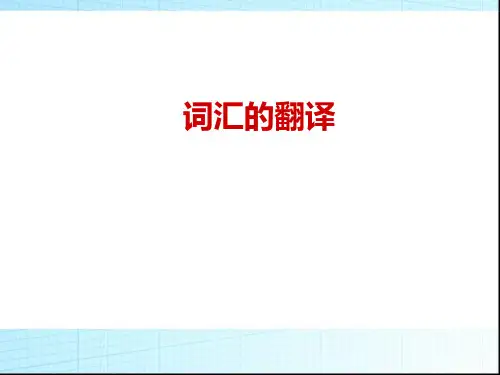

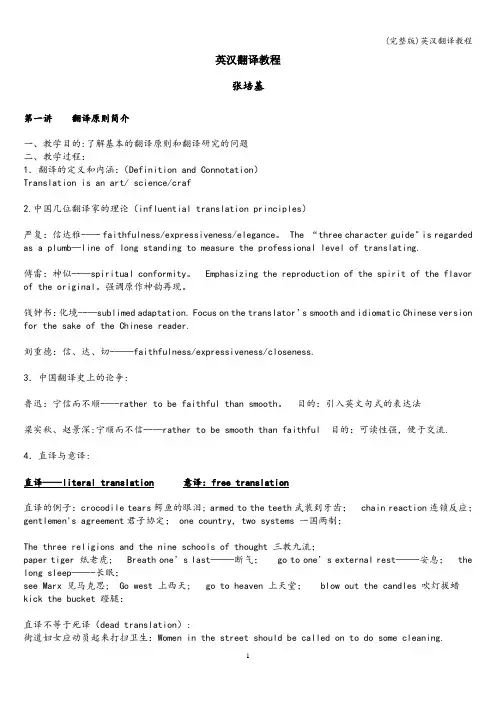
英汉翻译教程张培基第一讲翻译原则简介一、教学目的:了解基本的翻译原则和翻译研究的问题二、教学过程:1.翻译的定义和内涵:(Definition and Connotation)Translation is an art/ science/craf2.中国几位翻译家的理论(influential translation principles)严复:信达雅-—- faithfulness/expressiveness/elegance。
The “three character guide" is regarded as a plumb—line of long standing to measure the professional level of translating.傅雷:神似--—spiritual conformity。
Emphasizing the reproduction of the spirit of the flavor of the original。
强调原作神韵再现。
钱钟书:化境--—sublimed adaptation. Focus on the translator’s smooth and idiomatic Chinese version for the sake of the Chinese reader.刘重德:信、达、切-——faithfulness/expressiveness/closeness.3.中国翻译史上的论争:鲁迅:宁信而不顺-—-rather to be faithful than smooth。
目的:引入英文句式的表达法梁实秋、赵景深:宁顺而不信--—rather to be smooth than faithful 目的:可读性强,便于交流.4.直译与意译:直译—--literal translation意译:free translation直译的例子:crocodile tears鳄鱼的眼泪; armed to the teeth武装到牙齿; chain reaction连锁反应;gentlemen's agreement君子协定; one country, two systems 一国两制;The three religions and the nine schools of thought 三教九流;paper tiger 纸老虎; Breath one’s last——-断气; go to one’s external rest——-安息; the long sleep——-长眠;see Marx 见马克思; Go west 上西天; go to heaven 上天堂; blow out the candles 吹灯拔蜡kick the bucket 蹬腿:直译不等于死译(dead translation):街道妇女应动员起来打扫卫生:Women in the street should be called on to do some cleaning.“In the street" should be replaced by “in the community”.她一大早起床,进城,见到了她的公爹:She got up early, went to the town and saw her public father。


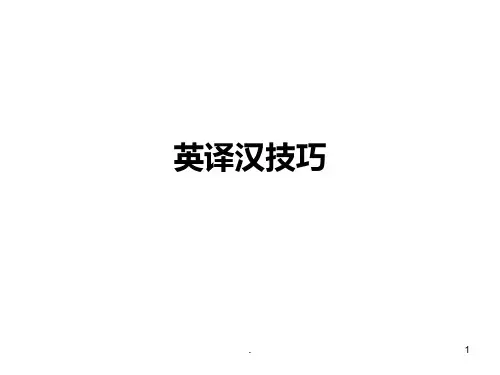

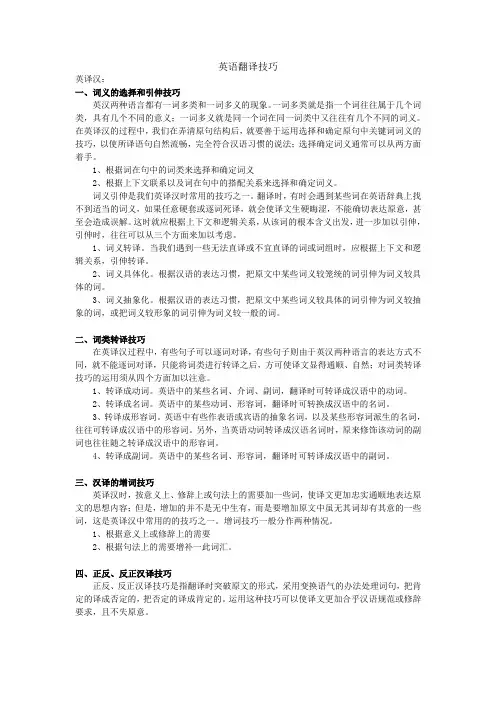
英语翻译技巧英译汉:一、词义的选择和引伸技巧英汉两种语言都有一词多类和一词多义的现象。
一词多类就是指一个词往往属于几个词类,具有几个不同的意义;一词多义就是同一个词在同一词类中又往往有几个不同的词义。
在英译汉的过程中,我们在弄清原句结构后,就要善于运用选择和确定原句中关键词词义的技巧,以使所译语句自然流畅,完全符合汉语习惯的说法;选择确定词义通常可以从两方面着手。
1、根据词在句中的词类来选择和确定词义2、根据上下文联系以及词在句中的搭配关系来选择和确定词义。
词义引伸是我们英译汉时常用的技巧之一。
翻译时,有时会遇到某些词在英语辞典上找不到适当的词义,如果任意硬套或逐词死译,就会使译文生硬晦涩,不能确切表达原意,甚至会造成误解。
这时就应根据上下文和逻辑关系,从该词的根本含义出发,进一步加以引伸,引伸时,往往可以从三个方面来加以考虑。
1、词义转译。
当我们遇到一些无法直译或不宜直译的词或词组时,应根据上下文和逻辑关系,引伸转译。
2、词义具体化。
根据汉语的表达习惯,把原文中某些词义较笼统的词引伸为词义较具体的词。
3、词义抽象化。
根据汉语的表达习惯,把原文中某些词义较具体的词引伸为词义较抽象的词,或把词义较形象的词引伸为词义较一般的词。
二、词类转译技巧在英译汉过程中,有些句子可以逐词对译,有些句子则由于英汉两种语言的表达方式不同,就不能逐词对译,只能将词类进行转译之后,方可使译文显得通顺、自然;对词类转译技巧的运用须从四个方面加以注意。
1、转译成动词。
英语中的某些名词、介词、副词,翻译时可转译成汉语中的动词。
2、转译成名词。
英语中的某些动词、形容词,翻译时可转换成汉语中的名词。
3、转译成形容词。
英语中有些作表语或宾语的抽象名词,以及某些形容词派生的名词,往往可转译成汉语中的形容词。
另外,当英语动词转译成汉语名词时,原来修饰该动词的副词也往往随之转译成汉语中的形容词。
4、转译成副词。
英语中的某些名词、形容词,翻译时可转译成汉语中的副词。
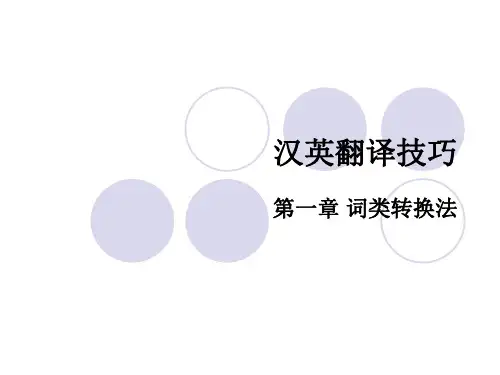
词汇翻译技巧一、词义的选择(Diction)1. 注意词的搭配汉语和英语两种语言在长期使用过程中形成了各自的固定词组和搭配,所以不能把汉语字词的搭配用法生搬硬套到英语译文中去。
汉、英两种语言的动宾搭配也有不同:例:学文化learn to read and write学知识acquire knowledge学外语study a foreign language学鸟叫imitate birds’ crying同样:发展经济develop our economy开发水资源develop the water resources冲洗胶卷develop a film展开说明develop an idea2. 根据上下文正确理解原文的词义有些汉语说法英译是按字面翻译,具体翻译时应视具体语境而定。
例1:有市场、有效益的速度,才是真正的发展,才是硬道理。
译文:Sound economic growth must be based on strong market demand and good economic returns. This is a .注意:“硬道理”也可根据我们中国文化的“异化”理解,翻译成:.例2:这种情况必须改变译文:This must change.分析:此处要正确理解原文的词义。
汉语措辞中的“情况”一词的基本意义与英语中的circumstance, situation, condition等词相近,但是究竟怎样翻译,还需要根据上下文来决定。
二、词的增补(Amplification)词的增补又常叫增译/增词法,是为使译文准确、通顺、达意。
增译有语义性增译修辞性增译,还有注释性增译(文内阐释或文中夹注)1.增补主语汉语中无主语的句子很多,汉译英时要根据上下文的意思选择适当的代词或名词补做主语。
增加什么主语取决于上下文。
例1:知己知彼,百战不殆译:2. 增补非人称的或强调句中的itit可以指天气、时间,还常用来表示强调、代替不定式等。